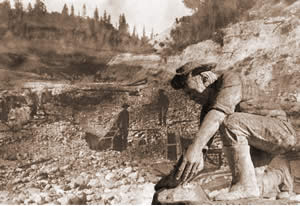Alleghany
Angels Camp
Coloma
Columbia
Dutch Flat
Folsom
Grass Valley
Hammonton
Iowa Hill
Jackson - Plymouth
La Porte
Malakoff
Nevada City
Placerville
Poker Flat
Auburn History
Gold Districts - Foresthill
|
FOREST HILL Location. The Forest Hill district is in south-central Placer County in the general vicinity of the town of that name. This district is fairlv large in area and includes not only the "diggings" 'at Forest Hill but those at Bath to the east, Todd Valley and Dardanelles to the southwest, and Yankee Jims to the northwest. The district is principally a placer-mining one, although there have been some productive quartz mines. History. Gold was discovered here in 1850. By 1852 the area was highly productive. In that year the Jenny Lind mine was discovered, and hydraulic mining was introduced at Yankee Jims by Colonel McClure. The town was an important trading center in those days. By 1868 the mines in the vicinity of the town had yielded more than $10 million. Large-scale hydraulic mining continued until the early 1880s and drift mining until the early 1900s. There was appreciable activity in the district again in the 1930s and early 1940s, and a few mines, such as the Paragon and Three Queens, have been worked since. Forest Hill is now an important lumbering center. The total output of the district is estimated to be at least $25 million, and it may be considerably more. Geology. The main early Tertiary channel of the Middle Fork of the American River enters the district from Michigan Bluff on the east. At Bath it turns north and then west and southwest and continues southwest through Forest Hill. At the Dardanelles mine west of Forest Hill, the channel swings northwest to Yankee Jims and then north to the Iowa Hill district. An intervolcanic channel extends west-southwest from Baker Ranch to north of Forest Hill. Another intervolcanic channel extends south-southwest between the above and Yankee Jims. The older quartzitic gravels near bedrock are coarse and well cemented and have yielded the most gold. Much of the gravel is overlain by rhyolite and andesite. Bedrock is slate with some phyllite, schist, and serpentine. Some of the gold-quartz veins were rich, especially those that occur near serpentine. The veins are usually three to four feet thick and strike in a northwesterly direction. A number of small but rich pockets were found in the Three Queens mine, the principal lode mine in the district. Mines. Placer: Baker Divide; Baltimore; Big Spring $150,000; Dardanelles $2 million+; Excelsior; Florida; Georgia Hill, Yankee Jim and Smiths Point, together $5 million; Grey Eagle; Homestake; Independent, New Jersey and Jenny Lind, together $2,653,000; Mayflower $1 million; Maus; Paragon $2.65 million+; Peckham Hill and Todd Valley, together $5 million; Pond; San Francisco- Small Hope; Yankee Jims. Lode: Dry Hill, Eureka, Cons. International, Mitchell, Three Queens $100,000+. Excerpt from: Gold Districts of California, by: W.B. Clark, California Department of Conservation, Division of Mines and Geology, Bulletin 193, 1970. |


